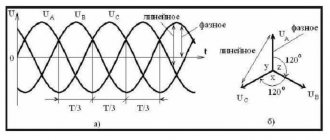What is ODN for electricity?
The easiest way to explain the meaning of this term is with an example. Let's say there is a standard apartment building connected to the power supply. The total expense in this case will include the following components:
- Electricity consumed by individual consumers.
- Electricity necessary to power the equipment of common home areas (lighting of stairwells, elevator equipment, technological losses on internal lines, etc.). This item of expenditure is called “general household needs” or abbreviated as GDN.
Consumption for the first item is determined according to the readings of individual meters. For the second, a special calculation is made, the results of which are reflected in the corresponding column of the utility payment receipt.
Receipt with column ONE electricity
What is included in the ODN?
Residents of apartment buildings, having received a receipt that includes payment for one-time expenses, often wonder what this category of expenses includes. Let us answer this question by providing a drawing for clarity, listing common household appliances.
Equipment included in the ODN
Designations:
- a) Lighting fixtures in staircases, attics and basements.
- b) Lighting systems for local areas.
- c) Elevator equipment.
- d) Security systems (intercoms, video surveillance, etc.).
- e) Fire alarm.
- f) Providers' equipment.
- g) Antenna amplifiers.
- h) Pumping equipment.
- j) Electricity losses.
Please note that the last point includes both losses of the intra-house network and unauthorized connections that bypass individual devices that take into account electricity consumption. That is, in this case we can talk about stealing electricity from neighbors in the house.
Above the norm
Consumption in excess of electrical consumption standards is already, by law, theft. There may be different reasons:
- Theft, including illegal connection.
- Consumption of electricity without providing actual reporting of electricity consumption.
- When the apartment is rented and quite a lot of people live in it without registration.
- Late submission or theft of energy meter readings.
- Losses inside a housing facility.
- Malfunction of the meters themselves.
Payment for one day
According to the Decree of the Government of the Russian Federation (No. 354), the entire volume of electricity consumed at the ODN is paid by the residents of the multi-apartment residential building. To avoid any discrepancies, we present a verbatim excerpt from the Resolution.
An example of an excerpt from RF PP No. 354 dated May 6, 2011
As you can see, the Resolution stipulates that all electricity costs for one-way distribution systems are borne by the owners of the residential building, regardless of the chosen form of management. Guided by this Resolution, management companies calculate the volume of electricity consumption for general house needs, the results obtained are entered into utility payment receipts. An example of such a receipt was shown in Figure 1.
How much does each person pay?
Let's say we have already calculated the electricity meters of all residents of the house and received a figure of 5000 kWh.
Now it is possible to calculate the amount of light used to meet the general needs of the house. From 6000 kWh we subtract 5000 kWh and get a remainder of 1000 kWh. You can begin to convert this amount into cash equivalent and distribute it among the receipts of each tenant. The basis for further calculations will be the parameter of the living area - both common for the entire house and for an individual apartment. Let us assume by default that the area of the house we are considering is 6000 m². It is necessary to understand what share of the payment for electricity on one unit falls on each square meter of the building. We carry out simple mathematical calculations: 1000 kWh/6000 m² = 0.166 kWh.
All that remains is a mere formality - multiply the area of a single apartment by the figure just obtained. Then we will find out what share of electricity according to ODN falls on each homeowner in our house.
For example, for an apartment with an area of 40 m², this figure will be 40 * 0.166 = 6.64 kWh. Now we know how much electricity we have to pay for.
To understand how much it will be in monetary terms, multiply the resulting figure by the current tariff for your region. Let's say you pay 5 rubles for each kilowatt. Then the monthly amount payable for electricity under ODN will be 5 * 6.64 = 33 rubles and 20 kopecks. It is logical that the larger the area of the apartment, the greater this indicator will be.
An example of calculating ODN for electricity in a multi-storey building
Despite the fact that tariffs and standards for electricity consumption differ in individual regions, the calculation formulas for calculating payments in the corresponding column remain unchanged. Let us give examples of calculations for a multi-apartment residential building with a common building meter for electricity consumption and an object where such a device is not available.
With counter
The calculation mechanism will be as follows:
- Readings are taken for a certain period from a common house electricity consumption meter. Let’s say the collective meter displays consumption of 6,500 kilowatt-hours. In this case, this is the total electricity consumption of a residential building, which includes the total volume of consumption of residential premises and the costs of one-room heating system.
- At this stage, a comparison is made of the total readings taken from individual electricity meters and the data from the common house meter. To perform this operation, it is necessary to sum up the consumption of each apartment. As a rule, data for the reporting period is collected on certain dates of the month. Such restrictions on the reading process are necessary to ensure that large discrepancies in the balance do not arise.
Let’s imagine that the total value of all residents’ electricity meter readings was 5,600 kilowatt-hours. That is, this is an indicator of the amount of electricity consumed by the owners of residential premises.
- Having received the consumption indicator for residential premises, it is subtracted from the total amount of electricity consumed. The result will be the number of kilowatt-hours per unit. In our case, the calculation will be as follows: 6500 – 5600 = 900.
- Now it is necessary to distribute (accrue) the ODN fee among the owners of the premises. Accruals are made to the owner based on the living space (RA) occupied by the apartment owners. For this operation, it is necessary to calculate the ratio between a square meter of housing and a unit of measurement for the resource spent on general house needs (kilowatt-hour for electricity).
Let's return to our example. Let's say the total living area in the house is 4200 m2. Therefore, in order to calculate the ratio, it is necessary to divide the total volume of ODN consumption (in our case 900 kWh) by the total amount of living space (4200 m2), we get: 900/4200 ≈ 0.214 kWh.
- Having calculated the ratio, it is easy to calculate the electricity consumption of one unit for any homeowner in the house. To do this, you need to multiply the resulting coefficient by the living area of a particular apartment. For example, if the owner has 42 m2 of living space, then the calculation of consumption, in our example, will be as follows: 42 * 0.214 = 8.988 kWh. Please note that the area of non-residential premises is not taken into account.
- At the final stage, the ODN fee is calculated; for this, the result obtained is multiplied by the tariff provided for the given region. Let's say our house is located in St. Petersburg, respectively, with a single-rate tariff of 4.32 rubles. for 1 kWh, the payment amount will be as follows: 4.32 * 8.988 ≈ 38.83 rubles.
- Payment is made for the consumption of electricity spent on general needs.
Closing the topic of calculations in the presence of a MOP meter, it should be noted that the weakest link in this accounting system is taking readings from individual devices. This is directly related to the influence of the human factor, for example, information was transmitted with an error or it is not possible to take readings due to the absence of residents. You should also take into account the time required to enter data into the common database and possible operator errors. Automated reading collection systems do not have such shortcomings. It will only take a few minutes to balance the electricity consumed by residents' networks, and 100% accuracy is guaranteed.
Without counter
The above method for calculating the consumption of resources (electricity) on one unit is applicable only if there is a common meter. If there is none, then a special standard provided for a given region is used as the coefficient necessary to calculate the use of electricity. The fee calculation principle is shown below.
Calculation of ODN in the absence of a common house meter
Information on the calculated coefficient (standard) for a specific region can be obtained on the official website of the regional administration. In this case, the coefficient acts as a limiting value; its revision is possible only upward. Such a decision can be made by a general meeting of residents (if we are not mistaken, in practice this has never happened before).
Standard for electricity and general household needs
There is no uniform standard for electricity valid throughout the country.
Each region of the Russian Federation sets its own indicators. Below are the indicators that apply in some regions: In Moscow and the Moscow region. In high-rise buildings without elevators and electrical installations for heating and water heating, the standard is 0.61 kW/h, with elevators but without appropriate installations - 2.88 kW/h, without elevators, but with electrical devices for heating and water heating, regardless of season - 0.61 kW/h.
In St. Petersburg and Leningrad region. In apartment buildings without elevators and installations for heating and water heating - 0.43 aKW/h, with pumps - 0.94 kW/h, with elevators, but without installations - 1.66 kW/h, without elevators, but with installations in heating period - 4.87 kW/h, and outside the heating period - 1.36 kW/h.
In the Rostov region. If only light bulbs are installed in a high-rise building, then the payment will be 0.6 kW/h. But with an elevator, the costs will be 1.7 kW/h, and with pumps – 0.9 kW/h.
In the Novosibirsk region. For three-story apartment buildings for 1 sq. m of electrical energy will have to pay 0.907 kW/h, for five-story apartment buildings - 2.210 kW/h, for twelve-story apartment buildings - 4.411 kW/h, for thirteen-story apartment buildings - from 6.128 to 7.014 kW/h, depending on whether an individual heating point is installed there or not .
In the Saratov region. Residents of two-story houses pay 0.59 kW/h for light in the entrance, of four-story houses - 0.84 kW/h, and if there is a pump, then the standard will be 0.97 kW/h, in nine-story houses it will be 1.82 kW/h, but with an elevator - 2.4 kW/h, with a pump - 2.10 kW/h, with power units - 2.72 kW/h.
Which is more profitable with or without a meter?
As an example, let us give the norms of electricity consumption for general household needs for the Nizhny Novgorod region.
ODN consumption standards in Nizhny Novgorod (for example)
If you track thematic information on local forums, it turns out that installing MOS devices is profitable, since in this case you have to pay less for utility resources spent on general needs.
A situation where a common electricity meter is installed, and the volume of consumption of utility resources exceeds the regional norm, is fundamentally impossible. In this case, everything points to the fact of loss of resources due to the fault of the management company.
If a common house meter is installed
If there is a common household meter, employees of the management company take readings from it monthly.
The devices show the amount of electricity, as well as heat, gas and water consumed from the entire building, and from each apartment separately. After collecting readings from apartment metering devices, a calculation is made for an individual apartment and the amount of consumption by all residents of the house is displayed. Both values are compared, the remaining difference becomes the expense for general household needs.
To obtain correct data, all values must be taken in the same period. The amount is distributed among users of the premises taking into account the occupied space.










